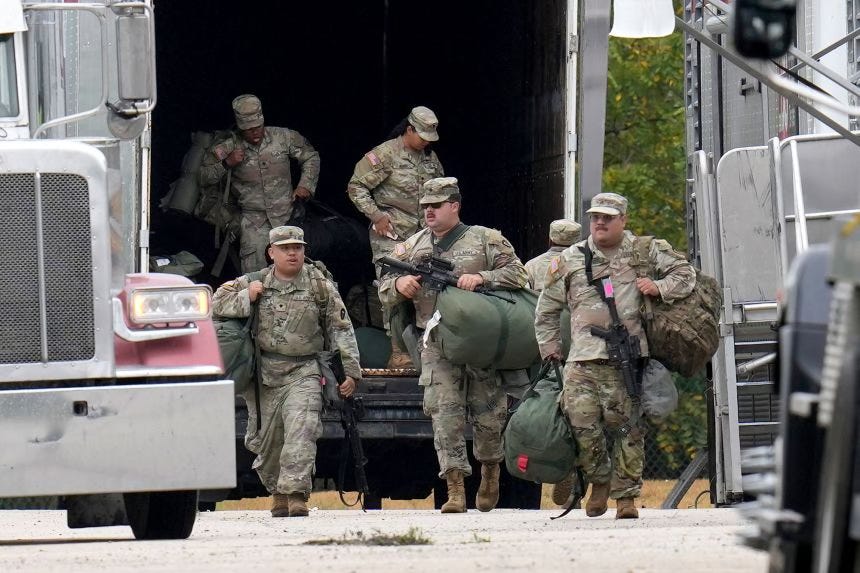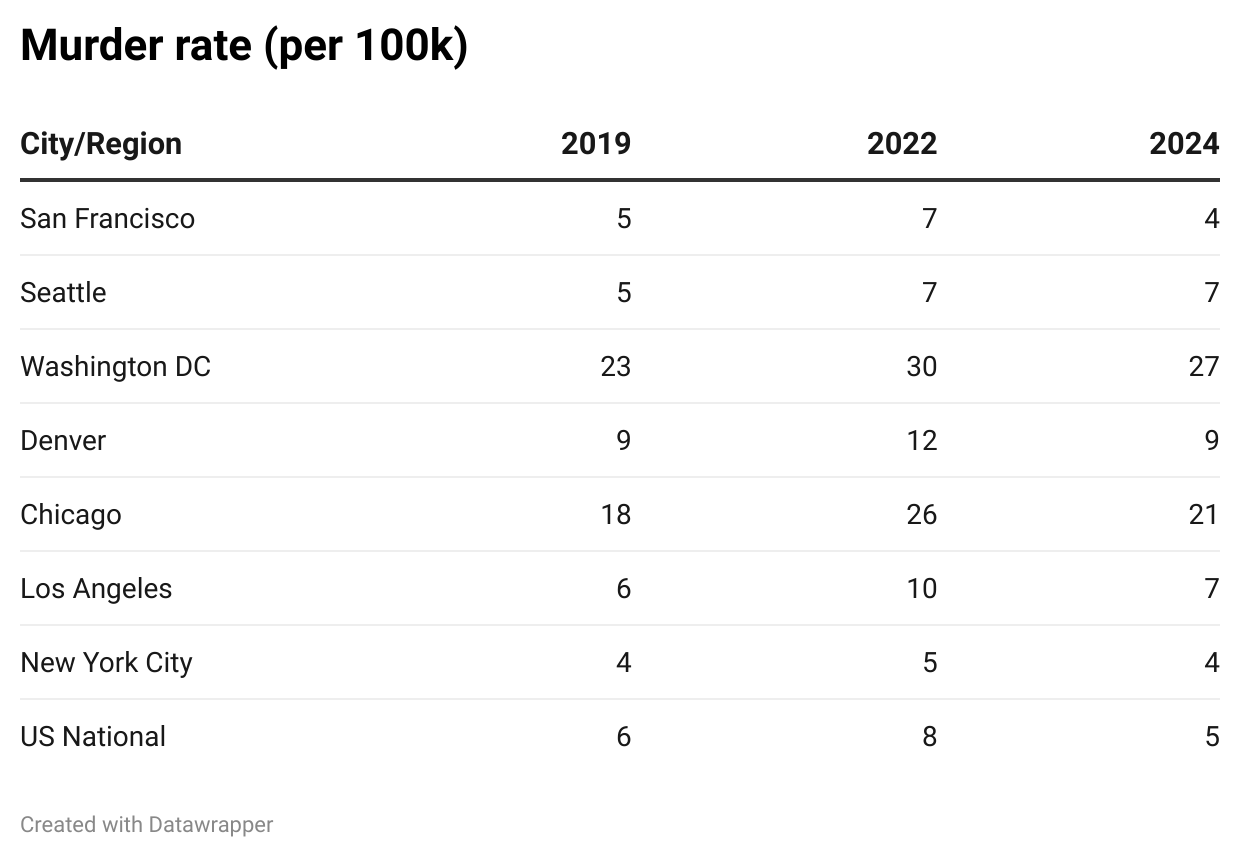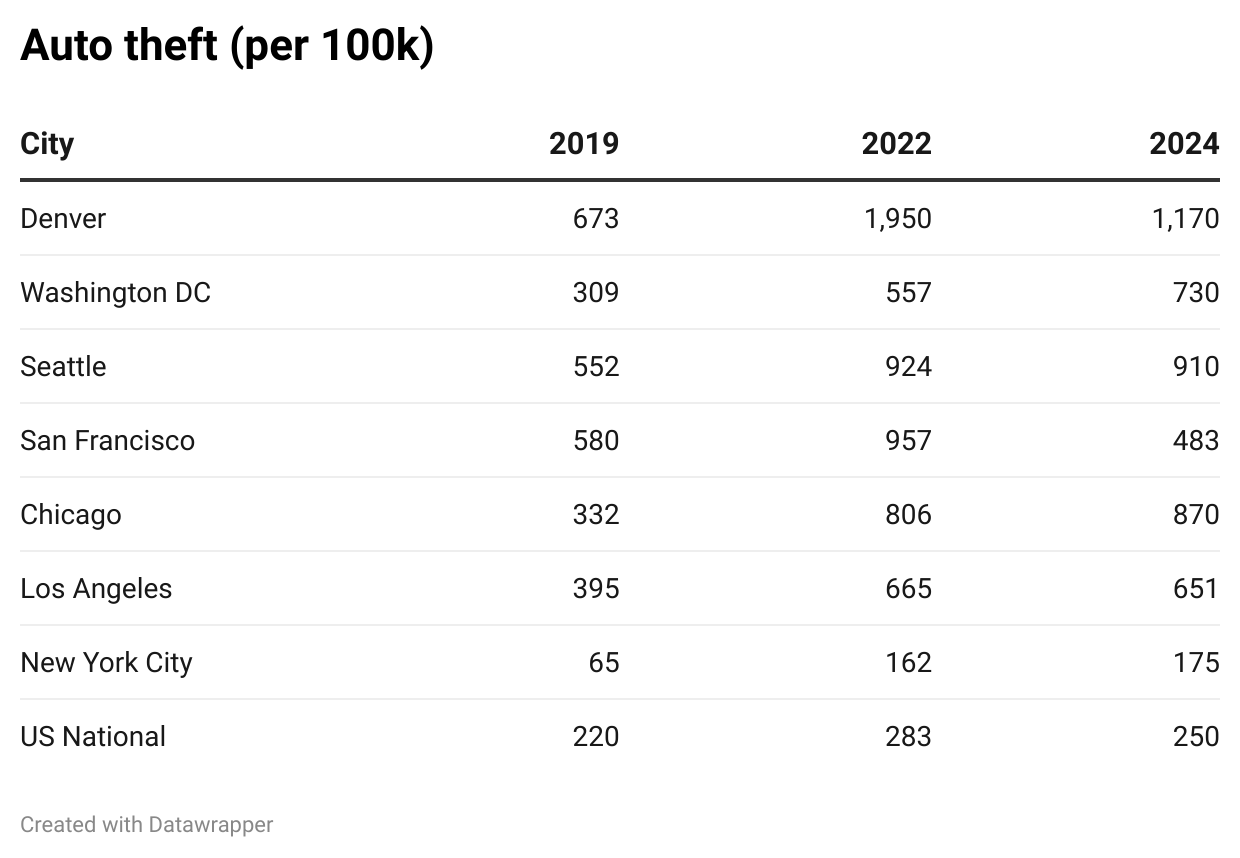The Two Crimes That Can’t Lie
Cities are getting more dangerous. Should the federal government intervene?
Trump is threatening to send the National Guard to Chicago. Marc Benioff asked for a deployment to San Francisco, then quickly backtracked.
Before we get to Trump and federalism, answer a simpler question: Are US cities getting more dangerous?
The official answer is clear:
San Francisco Mayor Daniel Lurie: “Crime down nearly 30%, car break-ins at 22-year lows, homicides at 70-year lows.”
Illinois Governor JB Pritzker: “Murders down 32%... shootings down 37%... robberies declined 34%.”
California Governor Gavin Newsom: “Overall violent crime down 12.5%... a 34% decline in robberies.”
So why did your car get broken into last month? Why are your neighbors installing Ring cameras? Why does no one go downtown anymore?
If we’re at “22-year lows,” why doesn’t anyone feel safe leaving the office at night?
Someone is lying—or more precisely, someone has figured out how to make the numbers lie for them.
The Two Honest Crimes
Most crime statistics are useless.
Assault? Depends who reports it. Burglary? Only if victims bother filing. Shoplifting? Retailers stopped calling police entirely- why bother when prosecutors won’t file charges under $950?
Reporting rates collapsed. Definitions shifted. What counts as “crime” is increasingly a political choice.
But two crimes can’t be faked: homicide and auto theft.
Homicide is the proxy for social cohesion. Bodies demand autopsies. Medical examiners don’t answer to mayors. Families demand justice. You can’t hide a murder in a spreadsheet. When homicide rises, social fabric is tearing: neighbors turning on neighbors, disputes escalating to violence. When it falls, communities are stable. People have hope. Trust exists.
Auto theft is the proxy for institutional deterrence. Stolen cars trigger insurance claims that require police reports—paper trails politicians can’t erase. More importantly, auto theft isn’t about desperation. Nobody steals a car because they’re hungry. It’s pure calculation: (Probability of getting caught) × (Severity of punishment) = Risk.
When auto theft explodes, the criminal justice system has stopped functioning. High auto theft means criminals calculate the risk as zero. When consequences disappear for property crime, you’re advertising that the system won’t protect anything.
Together, these metrics tell you everything: Homicide reveals whether your neighbors might hurt you. Auto theft reveals whether anyone will bother stopping property crime.
What the Numbers Actually Say
Let’s start with what everyone agrees on: homicide is genuinely falling. The FBI reports murder down 14.9% in 2024. These aren’t statistical tricks: fewer people are killing each other. That’s real progress.
This is the number politicians want you to focus on. And they’re right to celebrate it—falling homicide means something fundamental is working. The social unrest of the pandemic is over. Communities aren’t tearing apart. Social bonds remain intact. People aren’t desperate enough to kill.
But here’s where the lying starts.
When politicians claim “crime is falling,” they’re obscuring the problem in two ways.
First, they compare to pandemic highs. Crime across the board spiked in 2020-2022, then fell back. But “down from a historic spike” isn’t the same as “safe.” Most cities remain well above 2019 levels; they just hope you forgot what normal used to feel like.
Second, they use falling homicide rates to hide rising property crime. When pressed on auto theft, they pivot: “But overall crime is down!” They’re betting you won’t ask which crimes are down and which are up.
Statistical sleight of hand.
Here’s what the data actually shows: Rank district attorneys by how progressive their platform is—the list matches per capita auto theft rates almost perfectly. Every city with auto theft rates above twice the national average has a DA who ran explicitly on decarceration.
The divergence proves the manipulation. If cities were genuinely getting safer, both numbers would move together. Social breakdown drives both murders and property crime. Social stability reduces both.
Instead we see: social stability (falling homicide) plus institutional collapse (exploding auto theft).
That combination isn’t random. It reveals something specific: these cities stopped enforcing property crime laws. This isn’t incompetence; it’s deliberate policy producing exactly the results progressive prosecutors promised: fewer people in jail, more property crime on the streets.
The New York Proof
New York City is the control group that destroys the excuses of progressive politicians.
Compare New York to Chicago. Similar size. Similar density. Similar diversity. Both progressive. Both expensive. Both Democratic strongholds for decades.
NYC’s auto theft rate: 175 per 100,000, below the national average of 250.
Chicago’s: 870 per 100,000, 350% above the national average.
Chicago residents are 3.1 times more likely to have their car stolen than New Yorkers.
That’s not a rounding error. That’s policy.
The difference isn’t policing budgets. It isn’t poverty or inequality. It’s consequences. New York maintained prosecution. District attorneys continued filing charges. Courts processed cases. When you steal a car in New York, you get arrested, prosecuted, and sentenced. The system still works.
And New York does this while remaining progressive on everything else. Sanctuary city policies. Substantial social services. Housing regulations. Criminal justice reform for violent offenders.
Turns out cities don’t need authoritarian rule to maintain order. They just need to enforce their laws. New York proves you can be progressive AND prosecute car thieves. The choice progressive governors pretend doesn’t exist, already exists in America’s largest city.
The Pritzker Problem
Governor Pritzker’s response to Trump reveals the core hypocrisy.
Trump’s threat to send federal troops violates federalism. Pritzker is right to oppose it.
But his outrage rings hollow: Pritzker controls the Illinois National Guard. Chicago’s murder rate is 500% above the national average. Auto theft is 350% above. He could deploy state forces tomorrow.
He won’t. Because that would require admitting there’s a problem. Pritzker won’t even acknowledge Chicago’s crime crisis, he just cites falling homicides while ignoring that both murders and auto theft remain well above 2019 levels. He hopes you don’t ask about your stolen car, or remember what safe used to feel like.
Ed Koch didn’t have this problem. In the 1970s, he ran for mayor calling New York “plagued by filth, crime, bankruptcy, and racial tensions.” He acknowledged the crisis, then fixed it. He reformed policing to work, not out of existence. Police presence increased. Criminals got prosecuted. Social services expanded. He didn’t pretend you had to choose.
Pritzker can’t claim New York’s approach is impossible, it exists. He can’t claim prosecution abandons progressive values, New York proves otherwise. He can’t claim density makes it unworkable, New York is denser.
So instead: constitutional theater. Passionate speeches about federalism while refusing to use his own Guard. The working-class nurse misses shifts because her car was stolen. Politicians debate federalism on TV. Workers lose their livelihoods over a lie.
By refusing to deploy state resources, Pritzker creates the vacuum Trump wants to fill. The choice isn’t Trump’s troops or nothing—it’s Trump’s troops or Pritzker’s Guard.
When you refuse to govern, you invite someone else to govern for you.
The Choice
People will tolerate inequality. Bureaucracy. Bad schools. High taxes.
They won’t tolerate chaos. They won’t forgive being lied to about it.
This is how republics die: state governments fail to govern, lie about the results, then cry tyranny when someone else steps in.
Progressive governors face a choice they pretend doesn’t exist: Make your cities safe, or watch people invite federal power permanently.
Bodies and stolen cars don’t lie. Politicians do.




